Read the previous post about the proposed Beacon's trail here: Leucadia!: Beacon's Beach Trail Access
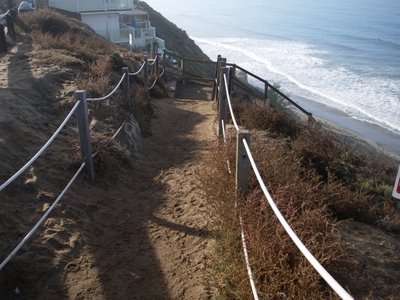
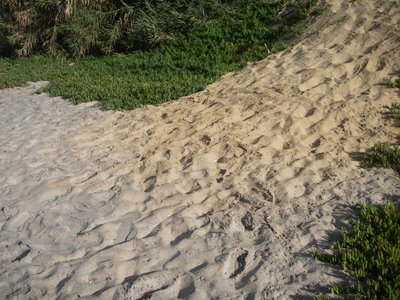
Here is cliff erosion meeting the beach sand. The experts will tell you that the majority of our beach sand comes from the cliffs and that is why we cannot build sea walls of any kind. As a 36 year old surfer who grew up in Leucadia I can firmly tell you that there is a clear difference between dirt and sand. Classic Leucadia beach sand is mostly black and is sticky. It comes from huge sand basins offshore that spring and summer south swells push onto the beach. During the winter when we have big north swells and storms we lose a lot of sand. It's the ebb and flow of the beach. I believe the Surfrider Foundation has a political agenda against beach property owners so they overhype the amount of "sand" we get from the cliffs.

The natural beauty of the bluff and vegetation meeting the beach is superior to any kind of wall. But what about safe public beach access? Is there a happy medium?
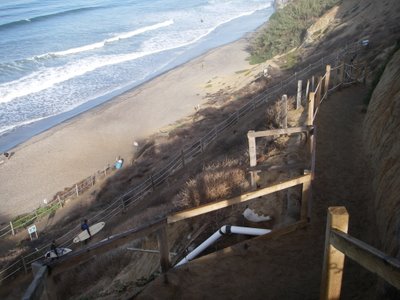
The trail and it's switchbacks are pretty cool. When I was a kid the switchbacks were concrete ramps that were slippery with sand and impossible to walk up in flip-flops. The current trail has some dicey sections that are sure to fall during the next good rain storm.
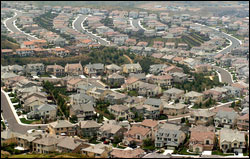
When Leucadia Blvd was extended to El Camino Real the city was thinking about the Ecke's new golf course and shopping center. Did they realize they were also linking the new shiny mega-sprawl known as San Elijo Hills to Beacon's (and the dysfunctional Leucadia/Vulcan/Hwy101 intersection). The Union Tribune reported that 170,000 people visited Beacon's last year. While I don't trust those beach people-counters that much (your surfboard appears to be getting counted as you walk by) it's obvious that since San Elijo Hills was built, Beacon's beach and it's soft breaking beginner friendly waves are more crowded than ever.
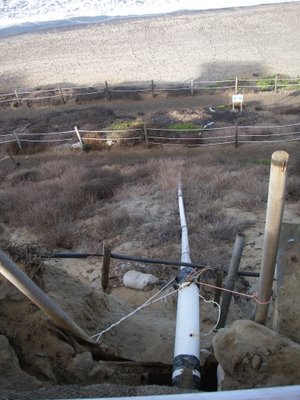
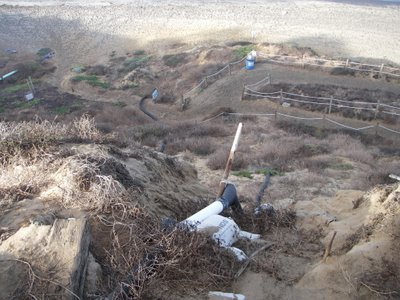
The new plan must address drainage.

The parking lot is always busy. It's a great place to pull up in the evening and watch the sunset. Unfortunately there is only one decent bench on the north end of the lot. I failed to take a photo of the north end but there is a lot of un-used space. There is a pay phone used by illegal aliens and drug dealers, a bike rack, one of those nice tiled art trash cans, a planter and not much else. This would be a good area for porti-potties.
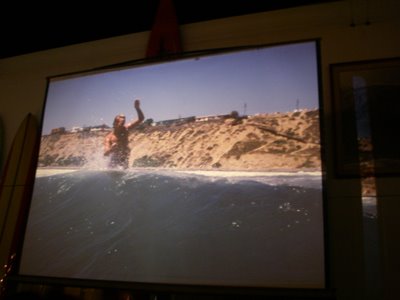
Bonus photo, a Ron Stoner shot of Billy Hamilton surfing Beacon's in the mid 60's summertime.
Several items which I think are noteworthy; the bluffs are effected by the wind. When Beacon's had thick healthy kelp beds not only did the surf stay glassy and good all day but the cliffs were not taking a constant beating from the wind. Our kelp beds are still trying to recover from the horrid chopping they took from the last and possibly illegal midnight run by the Kelpco and their kelp cutter ship.
Also, when I was a kid many areas of the bluffs were always damp, wet and drippy. Wild tomatoes grew all over the cliffs. Now the bluffs are bone dry and therefore brittle. You know when you build a sandcastle how the sand needs to be damp so it will stay up? The bluffs are the same way. Now that Encinitas has turned into suburbia, rain water no longer soaks into the ground and slowly seeps it's way towards the ocean. Now it just quickly runs off down the streets, into the gutters and goes gushing out into the ocean. I don't think this is reversable.
The majority of our sand migration down the coast is blocked by the Oceanside jetties. I don't see how our local cliff erosion is supposed to make up this massive quanities of sand that no longer reaches us.

JP- You may be a cool dude and I share your love of the ocean, but man, you are not a science major by no means. The reason the bluff dirt is different colors from the beach sand is the beach sand is washed of the Clay and other "dirty" lighter particles by ocean water. Just because the sand doesn't "look" like it came from the bluff, just mean it’s wasn't in the bluff at some point. Sand comes from the sediment from river mouths and eroding coastlines. Where do you think sand is generated from?
ReplyDeleteJust think about it. After a good rain, the ocean is brown and "dirty". After a few days the light stuff (brown/clay) dissipates in the ocean, the heavier "sand particles" (sandy looking) sinks to the bottom of the ocean near the surf zone. Just search the web a bit on sand migration and you'll learn alot. Thanks for your hard work in keeping us Leucadians in the know. Plus, the site is very entertaining. You should run for Council in '08. You have my vote.
Okay, yeah maybe. I still don't buy the fact that the majority of our sand comes from the eroding bluff.
ReplyDeleteThe ocean floor is vast and from my lifetime observations it is clear that we get most of our sand from swell action pushing the sand around.
You guys do realize that by pimping this "dirt is sand" thing that you are empowering the vile developer Michael D Pattinson. He wants to dump all his fill dirt from his mega Barratt American projects into our waterways and onto our beaches. The new hotel/resort/condo timeshare going in at the north end of Leucadia plans to dump all their extra construction dirt on the beach under the guise of replenishment. Personally I don't think guest paying $400 a night are going to want to stretch a towel out on this dirt/sand but hey, I'm not going to fight everybody on this.
How long does this dirt/sand take to become actual enjoyable sand?
Where do you think sand is generated from?
ReplyDeleteThe earth. 70% of it happens to be covered by water. It doesn't all come from the dry part.
OK - You want to blame sand loss on something, I'll give you two items.
ReplyDeleteThe first is the railroad. When they ran their tracks down the coast and changed the natural flow from the rivers and lagoons they screwed us. Yes, the track went in 80 years ago but sand replenishment is an on-going process. There is natural movement that brings sand in during storms but also natural movement as it is drawn back out and it has weight and so moves slowly downhill in the ocean. This is why it has as taken so long to become a problem.
The second is the Corp of Engineers, and the sand robbers mining the sand on the SanLuisRey. When the native vegatation is allowed to grow unchecked on the SanLuisRey there is no natural sand flow during great water years down the river. This in conjunction with the sand miners has helped to all but eliminate the natural flow from the back-country. Can't do much about it without opening the lagoons and rivers so they again flow naturally to the sea and stop dredging the sand from those sources. And yes, of course some comes from bluff failure.
When Sol. Beach got grade separation there was a big issue with the quality of the dirt that was being moved from the railroad zone to pillbox.
ReplyDeleteWhen they first dropped the "sand" off it was totally obvious that the material was different than what was on the beach before. A lot of the junk grains ended up being washed away but it did change the sand quality for years. There was a study to consider the effects of dumping the dirt. This is because not all dirt becomes good beach sand in the end.
As for the bluffs giving us sand. Well, anybody remember when you could climb/walk down the cliff at the check out spot at Pipes? There has been so much erosion in the last couple decades kids nowadays couldn't believe that is true.
There has been a lot of sand put on the beach from those bluffs. With the current situation, low sand levels and low input from the feeder rivers, the bluffs have become a more dominant source for beach sand. JP, that is certainly different than when you were a kid. I think the quality of sand has deteriorated from a surf perspective and that is probably because the stuff they dumped on the beach from dredging and the bluff sand doesn't make as good of sand bars.
You have to go to blacks or o'side to surf a good beach break now.
Gil forgot the jetties. The Oceanside Marina that is also used by the Marines causes a problem for sand movement in our cell. This is super important because majority of the river originating beach sand comes from the San Luis Rey River and those super productive rivers north of there.
ReplyDeleteProbably because of that engineer guy that use to write editorials in our local paper decades ago most people in Encinitas think that removing the freeway, RR, and 101 across San Elijo would result in fix to the sand "problem." This is not the big issue. Most of the local streams and rivers near Encinitas are not productive sources of beach sand, nothing like the San Luis, San Mateo, San Onofre, and Santa Margarita. Those rivers are either mined or on the wrong side of the jetties.
There is sooo much surfin myth / crazy wrong info being posted here in the guise of actual info that it approaches satire.
ReplyDeleteMuffassa and Gil have some good info. Thanks for sharing. You obviously know your sand migration when you’re using the word Cell. For those that do not know, Sand along our beaches runs from North to South with thousands of side trips out and in from the Ocean floor with the tides and seasons. Typically the winter northern storm pull the sand out to the Ocean and the summer southern swells push it back to the beach. Eventually and gradually our sand goes south and dumps into the La Jolla Cove leaving our in our “Cell”. Without a source of replenishment like a high sediment river or collapsing bluff, the supply runs out and we loose our beaches. Looks like our sand is running out again. Without a replenishment, the cobbles will be back within the next year or two, and then back to the ocean eroding the unbeached coast including the bluffs. Sand is the natural coastal protection against erosion and in much nicer then a wall anyway you look at it.
ReplyDeleteJP has it right again here. The bluffs can collapse and we will still not have "enough" sand. We need to fix the Beacon's access if we want to have an "easy" way to the beach. Otherwise, we all get to walk from Stone Steps or Grandview. Perhaps that is what the naysayers want? Access only for those young enough to brave a trail that is not safe, and not open. That would keep the crowds down, and certainly keep the families off the beach!
ReplyDeleteI am all for sand on the beach, and support sand replenishment programs. But even if we did that, the next big rainstorm will cause major problems with the Beacon's trail, just as it has in the past. No amount of sand on the beach will fix the problem at the top of the bluff. And I seriously doubt that seawalls caused "scouring" 100 feet up, near the parking lot.
ReplyDeleteIs different sand better than no sand? That is the question.
ReplyDeleteSand replenishment pumped from the ocean floor is the closest match for our beach sand. Unfortunately it costs money to pump it back to beach. Any ideas about how to raise the money for Beach Replenishment. I say put a new tax on every parcel in San Diego County earmarked solely for sand replenishment. Say at 5,000,000 parcels at $40 bucks per year you get $200,000,000. We could pump alot of sand on San Diego county beaches for $200,000,000 per year. Sand helps the entire san diego county economy, private coastal property owners, the entire US public, and many native species. I would gladly shell out $5/month for wide sandy beach like the ones I remember 20 years ago along our coast.
The proposed project is good. J.P. is right on that score.
ReplyDeleteThe Surfrider Foundation started out good, but has become a bunch of asshole attorney's looking for their next CEQA lawsuit paycheck.
From my perspective, the draw on our sand from the Lajolla has remained constant, but the supply of sediment has been restricted by suburban development, jetty and groin development, river damning, sand mining, AND the stupid over reaching NPDES BMP's that the regional water quality control board has foisted upon us all.
The only logical solution to all this man-made lack of beach sand is a regular and ongoing dredging program much like we had as a demonstration project in 2001-2002.
How to pay for it is the question. Encinitas has a dedicated source of funds as a result of 1998's prop R which dedicates 20% of the hotel T.O.T. taxes to sand replenishment (which by the way Bob Bonde and his group actively opposed!) but other cities like Solana Beach and Del Mar do not.
Encinitas has received a large state grant for this Leucadia project that will assure safe public beach access.
They should move forward with all due speed.
What ever happened to Dalagers turn recycled glass back into sand project. Is that a pipe dream, or can it be done and produce a less expensive evironmentally friendly product? This is something I know nothing about.
ReplyDeleteJP what time and where is this meeting tomorrow? I'm on the road in LA but I might get back to drop by if it is late enough. Thanks.
The new structures are not bad, in my opinion. I just wish the damn Coastal Commission would let people finish the projects they have started. Looking at half done projects suck. Finished second generation walls is just fine - as long as they are finished.
ReplyDeleteLet's not forget P3 aka Paul Ecke is a big surfer and that is why he wants his business to stay here --
ReplyDeleteMaybe he will donate the sand --
There is sooo much surfin myth / crazy wrong info being posted here in the guise of actual info that it approaches satire.
ReplyDeletethen please enlighten us. It sounds to me like a left wing political organization wants to block families from going to the beach and wants all private property to tumble into the sea.
The cliff dirt doesn't just look different from beach sand it feels different.
ReplyDeleteWhat year did prop R pass?
ReplyDeleteEncinitas voters in 1998 had approved a 2 percent increase in the city's hotel room tax to replenish sand. The city has banked nearly $2 million (2004)from the measure to spend on beach-building.
ReplyDeleteI voted NO on R because the sand the city buys is that horrid scratchy white river sand that hotels use for their fancy ashtrays.
Is a seawall is needed to support stairs at Beacons?
ReplyDeleteWhy not build a small foot print stair like the one at Grandview? There isn't a full seawall there and the stairs seem just fine. Also, the amount of beach at Beacons on a high tide is much greater than Grandview.
The stair and parking lot could be protected with terraces that wouldn't effect the surf or sand below as drastically. Seems like there is plenty of slope to the hill to work with.
Is a seawall is needed to support stairs at Beacons?
ReplyDeleteWhy not build a small foot print stair like the one at Grandview? There isn't a full seawall there and the stairs seem just fine. Also, the amount of beach at Beacons on a high tide is much greater than Grandview.
The stair and parking lot could be protected with terraces that wouldn't effect the surf or sand below as drastically. Seems like there is plenty of slope to the hill to work with.
Also, I don't think we can fault Surfrider for oposing a 400ft seawall.
ReplyDeleteIf they didn't, the corpos and beachfront home owners would never stop crying hippocrite.
Just as long as they support a plan for proper beach access that has minimal impact.
As a side note, here is October's Surfrider SD chapter meeting with a presenation on Kelp forests in San Diego, and what is affecting them.
http://video.google.com/videoplay?docid=-2794577409471308571&hl=en
Hey, I appreciate all the posts here, and I'm learning. Thanks, rob rhyne, I hadn't seen your posts, before.
ReplyDeleteMy feeling is that the City could do trail maintenance, or a small footprint staircase, as suggested. Sea walls are not a good option, and are to be considered only in an "emergency." The collapsing bluffs are a pre-existing condition.
Yes, it would be hypocritical to allow the city to do a big honkin' seawall, and to disallow the blufftop homeowners the same "right."
Stonesteps was closed for awhile. People had to go to Beacons, Grandview, Moonlight, or elsewhere. While they are fixing the trail or putting in stairs at Beacons, the same thing will have to happen. People can walk a ways, if necessary. The fact is, not every beach in Encinitas/Leucadia is a "family beach." That is nature's doing, too. Just like there are no stairs at Blacks.
The secret, I think, is balance and understanding. We need accurate information to be able to discern, to make good choices.
I admire the pro bono lawyers who work for the Surfrider Foundation, or for anyone, for that matter. Our legal system is a whole other "can of worms," but putting down individuals who donate their time and effort to help protect our beaches and our way of life is not constructive, or fair.
Encinitas is real good about making laws, passing ordinances, trying to exert more control, collect more taxes and fees, but not so great at doing correct environmental impact reports, and following Calif. environmental law.
I liked Dan's idea of rainbow sand on the beach from crushed glass, too, from recycling. If memory serves, the cost of crushing down the glass was higher than the cost of getting the sand from other sources. However, if crushed fine enough, I think it would be a wonderful experiment, and no, people would not get cut.
I wish we could get a grant for that kind of sand, and not for stupid sea walls.
Has anyone on this blog actually seen a plan for the Beacon's beach upgrade? I don't think that the wall will be very prominant, as most of it will be buried. And don't forget, it will be not just be a lump of cement - it will have the look and feel of a natural rock shelf - like many (natural) places in that area.
ReplyDeleteThe main purpose will be to anchor the toe of the bluff, to make it possible to do some work at the top of the bluff, so there can continue to be a parking lot. I guess a Grandview style staircase would work, but the parking lot would eventually (and perhaps sooner rather than later) would colapse, making parking more scarce that it already is.
JP, can you post some drawings here? It is always better to make an informed decsion, rather than a knee jerk reaction.
JP, I guarantee that the bluff does, indeed erode and create sand, but that sand won't help Beacon's, as it will end up somewhere south of you, say Del Mar or LJ.
ReplyDeleteObviously the kelp keeps the ocean surface glassier as it dampens the winds effect on the water, but I really don't see how the kelp, growing underwater, effects the wind, above the water, and how the wind hits the bluff.
????
If people absolutely need to sanitize the coastline and make it user friendly for those that can't walk down a cliff or from another access point, why not put in some elevated stairs, like there is at Grandview?
I have a great idea. If the persons that come for weekly rentals all brought a bucket of sand with them from Arizona we wouldn't have a sand problem. According to the nay sayers we have so many weekly renters we can't enjoy life so there must be enough of them to matter.
ReplyDeleteOn a serious note. In the 1970's before seawalls and after the oceanside marina was built we could drive our cars from ponto to moonlight at low tide. Since seawalls have been approved you cannot do that anymore. Perhaps there is a linkage.
Stairs like grandview, swamis or D street should work. We don't need a sea wall.
Carlsbad has jetties and seawalls and they have tons of sand.
ReplyDeleteYeah, we should turn Leucadia into Carlsbad. We could have unsurfable rock jetties everywhere, a stripmall esque boardwalk, whitewater views from our powerplant and RVs blocking the view all the way down Neptune.
ReplyDeleteSweet!
Neptune has a view?
ReplyDeleteSand by definition is fine particle rock, often quartz. But it can be volcanic, granitic, sandstone,or even coral. I have seen tropical beaches near river mouths that are more mud than sand. Clay and organic material don't make sand. Even glass will work, but glass splinters when broken and may need time to smooth the edges.
ReplyDeleteSand has texture, and the particles need to be in a certain size range. Too big and the result is small pebbles. Too small and it compacts or washes easily away under way action. If glass is used it can't be ground too finely. Cost is the main problem with glass.
That's "wave action," not "way action." Oy vey!
ReplyDelete